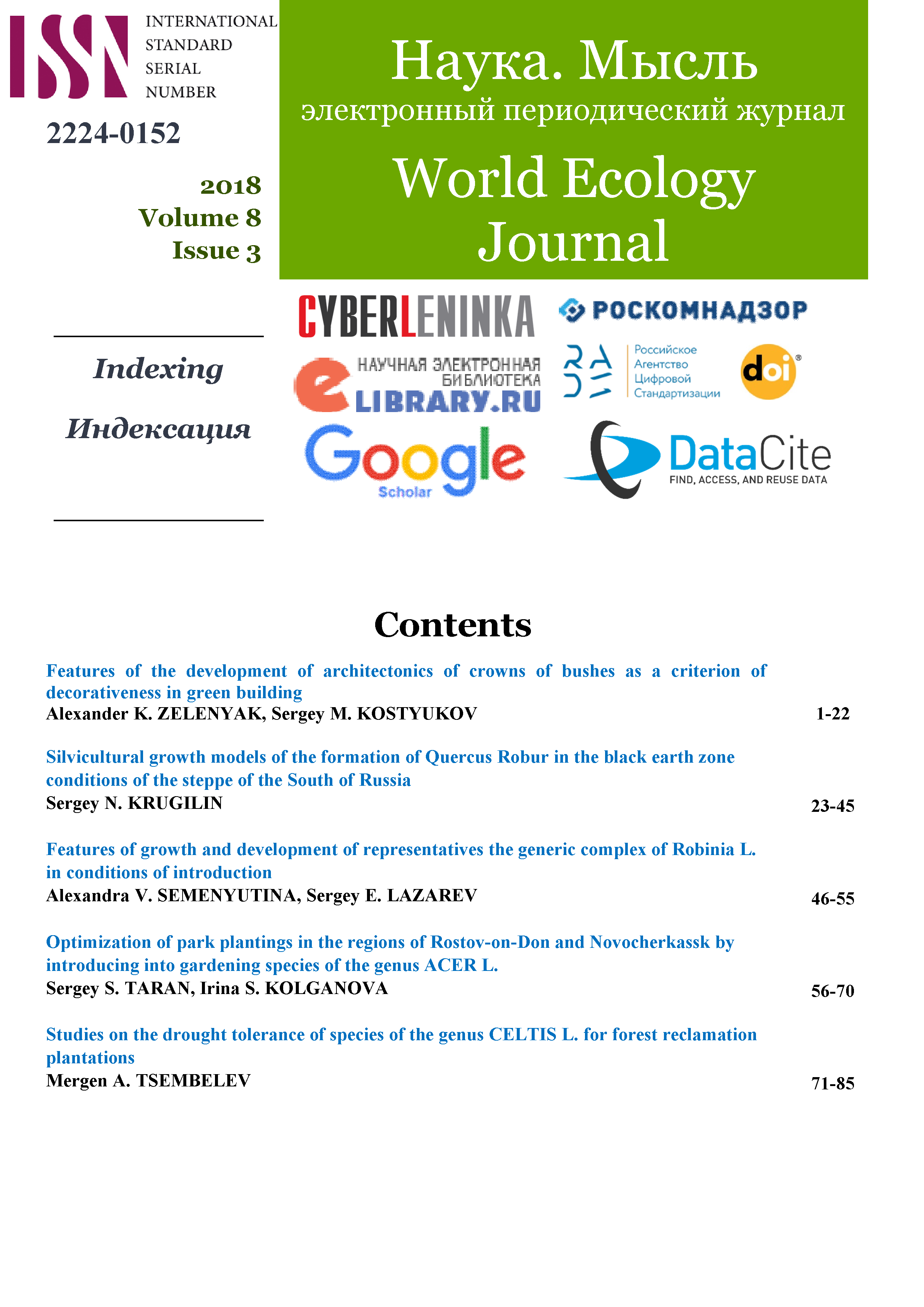Features of growth and development of representatives the generic complex of Robinia L. in conditions of introduction
DOI:
https://doi.org/10.25726/NM.2019.85.96.003Keywords:
Adaptation, growth, seasonal development, species, forms, Robinia, tolerance, prospects, limiting factors.Abstract
The generic complex Robinia L. is great interest for the mobilization of genetic resources in forest protection and landscaping of the arid region. Currently wide spread in planting and forest reclamation in the South received only one kind of locust - Robinia pseudoacacia L. ( R. leachate, or black locust).
The objects of research were species and forms of the genus Robinia: R. viscosa Vent.; R. luxurians (Dieck) S. K. Schneider.; R. pseudoacacia L.; R. pseudoacacia f. pyramidalis (Pepin) Rehd.; R. pseudoacacia f. unifoliola (Talou) Rehd.; R. pseudoacacia f. umbraculifera (DC) Rehd., introduced in the dendrological collections of the Volgograd region: FSC Agroecology RAS, cadastral number №34:34:000000:122, 34:34:060061:10 and the lower Volga station for selection of wood species, № 34:36:0000:14:0178.
The aim of the work is to study the features of growth and development of species and forms of the genus Robinia in terms of introduction and to determine the attitude to the limiting environmental factors of the dry steppe zone of the Lower Volga Region.
As a result of the research, the features of the growth and development of species and forms of the genus Robinia in terms of introduction were established, the ecological regularities of the formation of fruits and seeds were revealed, the threshold values of climatic factors in relation to the processes of life were determined, the features of growth processes in arid conditions were established.
It was found that the main factors limiting the adaptation of species and forms of the genus Robinia in the dry steppe conditions of the Lower Volga region is drought and extremely high and low air temperatures (-40°, + 43°). Tolerance of plants to these climatic factors is an important indicator of the success of their introduction.
Studies show that pre-existing differences in frost and drought resistance between species have been significantly reduced through gradual adaptation. This fact is explained by the high rate of adaptation of Robinia pseudoacacia to the limiting factors of the environment. Until recently, the air temperature of -25°C was considered critical for this species. As our studies have shown, this threshold in the process of acclimatization has significantly decreased and is -37°C.
All studied species of Robinia have a high degree of winter hardiness in the dry steppe zone of the Lower Volga region. Less hardy turned out to be only ornamental forms of Robinia pseudoacacia f. pyramidalis (Pepin) Rehd. and Robinia pseudoacacia f. umbraculifera (DC) Rehd., propagated in culture mainly vegetative way.
It is determined that Robinia can be successfully grown in different soil-geographical areas of the dry steppe zone of the Lower Volga region. Maximum size and longevity of the plantings of locust reach on Chernozem soils. The height of the plantings in the 20-year-old who-plant is 9-12 m. Planting on dark chestnut soils to 20-year-old reach 8-10 meter height, and on light chestnut-5-6 meters.
References
2. Baboshko OI The role of forest belts in changing the properties of soils under the canopy of a stand The collection of articles on the materials of the International Scientific Ecological Conference "Ecological problems of the development of agricultural landscapes and ways to increase their productivity." 2018. p. 418-420.
3. Trees and shrubs for protective afforestation G. P. Ozolin [et al.]. M .: Forest industry. 1974. with. 117-118.
4. Zhukova O.I. Studying the variability of seasonal development and growth of woody plants with the aim of selecting the form diversity for landscaping settlements O.I. Zhukova, V.A. Semenyutin, V.I. Petrov Science. Thought, 2016. №7-2.
5. Catalog of cultivated woody plants in Russia hole. ed. Karpun Yu.N. Sochi (Petrozavodsk), 1999. 173 p.
6. Kolesnikov A.I. Decorative dendrology. Moscow: “Forest industry”, 1974. 703 p.
7. Mattis G. Ya. Ways to improve the quality and effectiveness of artificial plantings in the arid region of the European territory of Russia. Forestry, 2003 No. 2. p. 37-43.
8. Guidelines for seed breeding of tree introductions in the arid zone A.V. Semenyutin [and others]. M .: Russian Agricultural Academy, 2010. 56 p.
9. Morozova E.V. The main results of the breeding of Robinia lzheakacii in the Lower Volga E.V. Morozova, A.P. Yozus, S.N. Kryuchkov Successes of Modern Natural Science, 2018. No. 12-2. with. 290-295
10. Workshop on plant growth and resistance: studies. allowance V. V. Polevoy et al. SPb .: S.-Peter. Univ., 2001. 212 p.
11. Semenyutina A.V. Adaptation of tree species under extreme conditions and the criteria for selecting the gene pool of economically valuable plants A.V. Semenyutina, I.P. Svintsov, A.Sh. Khuzhakhmetova, V.A. Semenyutina, O.I. Zhukova International Scientific Research, 2017. №1. with. 77-85.
12. Semenyutina A.V. Analysis of the bioresources of the Robinia, Gleditsia gene pool for forest reclamation complexes based on the study of adaptation to stress factors A.V. Semenyutin, A.D. Klimov Science. Thought, 2018. No. 2. p. 33-45.
13. Semenyutina A.V. Dendroflora of forest melioration complexes Ed. I.P. Svintsova. Volgograd: VNIALMI. 2013. 266 p.
14. Semenyutina A.V. Selection, preservation and perspectivity of using tree species to ensure the multifunctionality of degraded landscapes A.V. Semenyutina, A.Sh. Khuzhakhmetova, V.A. Semenyutina Reputiology, 2016. №1 (39). with. 83-88.
15. Alfred Rehder Manual for cultivated trees in North America. New York: The Mac millan company, 1949. 996 p.




